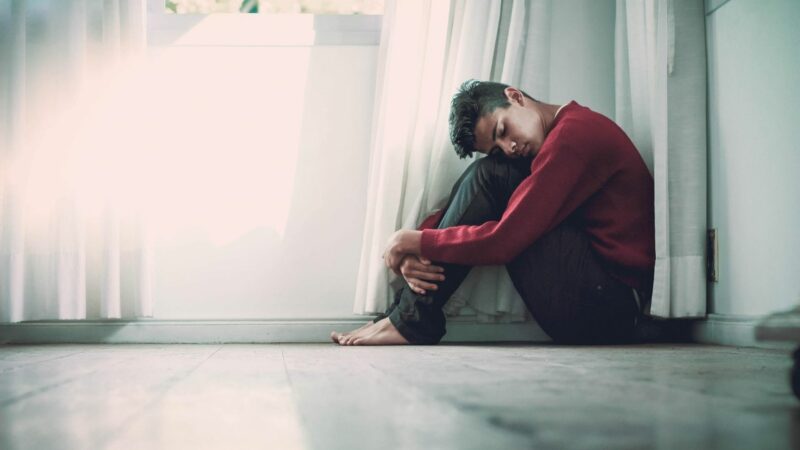- Progressive Muscle Relaxation
Progressive muscle relaxation is a technique that helps you relax your body by tensing and releasing your muscles so your body can naturally relax. There are many helpful videos and scripts on the internet. We’ve linked one helpful script with child-friendly imagery below.
- Deep Breathing Techniques
Try deep breathing techniques, such as balloon breathing. Imagine your stomach is a balloon. Breathe in and out slowly, counting up to five and back down to one, with your hands in a circle in front of your stomach. When you breathe in, move your hands to show that the balloon gets bigger, and when you breathe out, bring your hands back together as the balloon gets smaller. You can do this as many times as you like.
2. Try cognitive restructuring.
Parents, your child’s thoughts about an anxiety-inducing situation will affect how they respond and feel about it. Help your child to recognize and identify any unhelpful thoughts that they may have.
- Start by asking, “What do you think about [the stressful situation]?”
Your child may respond with negative thoughts like:
- “I can’t change the situation.”
- “This is the worst situation.”
Express interest in your child’s experience by being curious with them. Ask your child:
- “I wonder what happened right before [the behavior]?”
- “How are you feeling right now?”
- Next, challenge your child’s unrealistic and unhelpful negative self-statements and thoughts related to [the situation].
Encourage your child to think of positive self-statements that will help them combat the negative thoughts and manage this situation. Challenge your child’s negative thoughts:
- “Why is this the worst situation? You are safe and have Mom and Dad who love you.”
- “Yes, you can change the situation. You can change how you feel about it. If you want to feel good about the situation, then maybe you can try playing a game or calling your friends.”
3. Respond to your child’s behavior.
Sometimes your child may demonstrate behaviors that break household rules or can hurt themselves and others. It is important to help your child recognize their emotions and feelings behind those behaviors, while also stopping them gently and firmly so that no one gets hurt and your child does not develop habits that will make self-coping more difficult in the future.
- Here are some ways you can help your child change problematic behaviors:
- Create a structured plan for discipline appropriate for your child’s age and developmental level.
- Ensure that the consequence is appropriate for your child. For example, if your child is a preschooler, you may want to institute a “time-out” consequence for behaviors that need to be corrected.
- Make sure that you communicate the consequences of the behavior so that your child knows what will happen if they behave in certain ways.
- Follow through with the consequence, even when they protest.
As you learn more about your child’s anxiety, it will be important to assess the level of distress they feel and determine whether your child is in need of professional help.
- You must first consider whether the fear that your child is expressing is appropriate for their developmental level.
Ask yourself:
- “Is my child’s fear and distress realistic about the current situation?”
- “Does my child’s fear and distress interfere with their daily life (e.g., can they focus on schoolwork, engage in fun activities, etc.)?”
- “Is my child able to recover from distress? Does my child feel better after engaging in the above-described interventions?”
The interventions and techniques described above are helpful for children who are experiencing normal levels of anxiety. However, if your child’s anxiety is too distressing and has been negatively impacting their life such that, for example, your child cannot complete schoolwork, they cannot engage in fun activities, and they do not feel better after engaging in these interventions, then it will be important to seek professional help for your child.
Parenting is extremely challenging. Our hope is that these interventions and techniques can be a helpful starting point when trying to understand your child’s emotional needs, so that your family can thrive.
References
1. Duncan, L. G., Coatsworth, J. D., & Greenberg, M. T. (2009). A model of mindful parenting: implications for parent-child relationships and prevention research. Clinical child and family psychology review, 12(3), 255–270. https://doi.org/10.1007/s10567-009-0046-3.
About the Author

Hannah Ewert
Hannah Ewert is a PsyD candidate in the clinical psychology program at Fuller’s Graduate School of Psychology. Her research focuses on the impact of early relationships on child and adolescent mental health. As a clinician specializing in the care of children and adolescents, Hannah is interested in helping children flourish, and works to integrate research and clinical practice in order to help children and their families thrive.
- Progressive Muscle Relaxation
Progressive muscle relaxation is a technique that helps you relax your body by tensing and releasing your muscles so your body can naturally relax. There are many helpful videos and scripts on the internet. We’ve linked one helpful script with child-friendly imagery below.
- Deep Breathing Techniques
Try deep breathing techniques, such as balloon breathing. Imagine your stomach is a balloon. Breathe in and out slowly, counting up to five and back down to one, with your hands in a circle in front of your stomach. When you breathe in, move your hands to show that the balloon gets bigger, and when you breathe out, bring your hands back together as the balloon gets smaller. You can do this as many times as you like.
2. Try cognitive restructuring.
Parents, your child’s thoughts about an anxiety-inducing situation will affect how they respond and feel about it. Help your child to recognize and identify any unhelpful thoughts that they may have.
- Start by asking, “What do you think about [the stressful situation]?”
Your child may respond with negative thoughts like:
- “I can’t change the situation.”
- “This is the worst situation.”
Express interest in your child’s experience by being curious with them. Ask your child:
- “I wonder what happened right before [the behavior]?”
- “How are you feeling right now?”
- Next, challenge your child’s unrealistic and unhelpful negative self-statements and thoughts related to [the situation].
Encourage your child to think of positive self-statements that will help them combat the negative thoughts and manage this situation. Challenge your child’s negative thoughts:
- “Why is this the worst situation? You are safe and have Mom and Dad who love you.”
- “Yes, you can change the situation. You can change how you feel about it. If you want to feel good about the situation, then maybe you can try playing a game or calling your friends.”
3. Respond to your child’s behavior.
Sometimes your child may demonstrate behaviors that break household rules or can hurt themselves and others. It is important to help your child recognize their emotions and feelings behind those behaviors, while also stopping them gently and firmly so that no one gets hurt and your child does not develop habits that will make self-coping more difficult in the future.
- Here are some ways you can help your child change problematic behaviors:
- Create a structured plan for discipline appropriate for your child’s age and developmental level.
- Ensure that the consequence is appropriate for your child. For example, if your child is a preschooler, you may want to institute a “time-out” consequence for behaviors that need to be corrected.
- Make sure that you communicate the consequences of the behavior so that your child knows what will happen if they behave in certain ways.
- Follow through with the consequence, even when they protest.
As you learn more about your child’s anxiety, it will be important to assess the level of distress they feel and determine whether your child is in need of professional help.
- You must first consider whether the fear that your child is expressing is appropriate for their developmental level.
Ask yourself:
- “Is my child’s fear and distress realistic about the current situation?”
- “Does my child’s fear and distress interfere with their daily life (e.g., can they focus on schoolwork, engage in fun activities, etc.)?”
- “Is my child able to recover from distress? Does my child feel better after engaging in the above-described interventions?”
The interventions and techniques described above are helpful for children who are experiencing normal levels of anxiety. However, if your child’s anxiety is too distressing and has been negatively impacting their life such that, for example, your child cannot complete schoolwork, they cannot engage in fun activities, and they do not feel better after engaging in these interventions, then it will be important to seek professional help for your child.
Parenting is extremely challenging. Our hope is that these interventions and techniques can be a helpful starting point when trying to understand your child’s emotional needs, so that your family can thrive.
References
1. Duncan, L. G., Coatsworth, J. D., & Greenberg, M. T. (2009). A model of mindful parenting: implications for parent-child relationships and prevention research. Clinical child and family psychology review, 12(3), 255–270. https://doi.org/10.1007/s10567-009-0046-3.
About the Author

Hannah Ewert
Hannah Ewert is a PsyD candidate in the clinical psychology program at Fuller’s Graduate School of Psychology. Her research focuses on the impact of early relationships on child and adolescent mental health. As a clinician specializing in the care of children and adolescents, Hannah is interested in helping children flourish, and works to integrate research and clinical practice in order to help children and their families thrive.
Children and families’ often struggle with the ability to manage stress and anxiety. A helpful first step to managing your stress and anxiety during this time includes, conducting emotional check-ins, empathizing and responding to your child’s emotions, and teaching your child about anxiety.
In this post, we will be discussing three more evidence-based techniques to help increase relaxation, challenge negative thoughts, support positive behaviors and create a structured routine in your home.
1. Practice relaxation techniques.
Relaxation techniques can help reduce and ease some of your child’s physical experience of anxiety, such as headaches, stomachaches, muscle tension, or heart palpitations.
- Progressive Muscle Relaxation
Progressive muscle relaxation is a technique that helps you relax your body by tensing and releasing your muscles so your body can naturally relax. There are many helpful videos and scripts on the internet. We’ve linked one helpful script with child-friendly imagery below.
- Deep Breathing Techniques
Try deep breathing techniques, such as balloon breathing. Imagine your stomach is a balloon. Breathe in and out slowly, counting up to five and back down to one, with your hands in a circle in front of your stomach. When you breathe in, move your hands to show that the balloon gets bigger, and when you breathe out, bring your hands back together as the balloon gets smaller. You can do this as many times as you like.
2. Try cognitive restructuring.
Parents, your child’s thoughts about an anxiety-inducing situation will affect how they respond and feel about it. Help your child to recognize and identify any unhelpful thoughts that they may have.
- Start by asking, “What do you think about [the stressful situation]?”
Your child may respond with negative thoughts like:
- “I can’t change the situation.”
- “This is the worst situation.”
Express interest in your child’s experience by being curious with them. Ask your child:
- “I wonder what happened right before [the behavior]?”
- “How are you feeling right now?”
- Next, challenge your child’s unrealistic and unhelpful negative self-statements and thoughts related to [the situation].
Encourage your child to think of positive self-statements that will help them combat the negative thoughts and manage this situation. Challenge your child’s negative thoughts:
- “Why is this the worst situation? You are safe and have Mom and Dad who love you.”
- “Yes, you can change the situation. You can change how you feel about it. If you want to feel good about the situation, then maybe you can try playing a game or calling your friends.”
3. Respond to your child’s behavior.
Sometimes your child may demonstrate behaviors that break household rules or can hurt themselves and others. It is important to help your child recognize their emotions and feelings behind those behaviors, while also stopping them gently and firmly so that no one gets hurt and your child does not develop habits that will make self-coping more difficult in the future.
- Here are some ways you can help your child change problematic behaviors:
- Create a structured plan for discipline appropriate for your child’s age and developmental level.
- Ensure that the consequence is appropriate for your child. For example, if your child is a preschooler, you may want to institute a “time-out” consequence for behaviors that need to be corrected.
- Make sure that you communicate the consequences of the behavior so that your child knows what will happen if they behave in certain ways.
- Follow through with the consequence, even when they protest.
As you learn more about your child’s anxiety, it will be important to assess the level of distress they feel and determine whether your child is in need of professional help.
- You must first consider whether the fear that your child is expressing is appropriate for their developmental level.
Ask yourself:
- “Is my child’s fear and distress realistic about the current situation?”
- “Does my child’s fear and distress interfere with their daily life (e.g., can they focus on schoolwork, engage in fun activities, etc.)?”
- “Is my child able to recover from distress? Does my child feel better after engaging in the above-described interventions?”
The interventions and techniques described above are helpful for children who are experiencing normal levels of anxiety. However, if your child’s anxiety is too distressing and has been negatively impacting their life such that, for example, your child cannot complete schoolwork, they cannot engage in fun activities, and they do not feel better after engaging in these interventions, then it will be important to seek professional help for your child.
Parenting is extremely challenging. Our hope is that these interventions and techniques can be a helpful starting point when trying to understand your child’s emotional needs, so that your family can thrive.
References
1. Duncan, L. G., Coatsworth, J. D., & Greenberg, M. T. (2009). A model of mindful parenting: implications for parent-child relationships and prevention research. Clinical child and family psychology review, 12(3), 255–270. https://doi.org/10.1007/s10567-009-0046-3.
About the Author

Hannah Ewert
Hannah Ewert is a PsyD candidate in the clinical psychology program at Fuller’s Graduate School of Psychology. Her research focuses on the impact of early relationships on child and adolescent mental health. As a clinician specializing in the care of children and adolescents, Hannah is interested in helping children flourish, and works to integrate research and clinical practice in order to help children and their families thrive.




